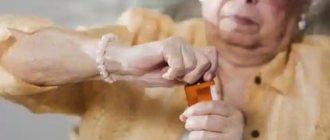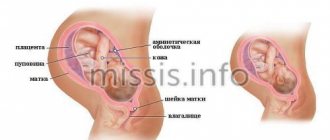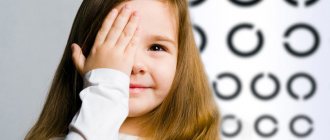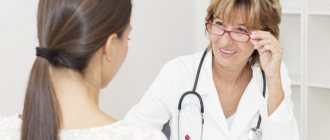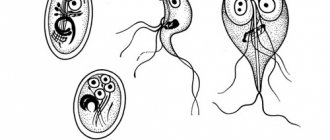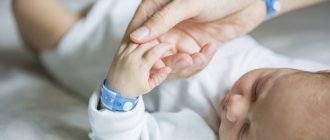In early childhood, neuropsychiatric disorders such as tics are quite common.
The scientific name is tic hyperkinesis. Parents immediately notice changes in the baby’s behavior. Uncontrolled movements of certain parts of the body or certain muscles in a child cannot but become a cause for concern and questions arise:
- Where did the disease come from?
- Could it have been prevented?
- What to do?
- How to treat?
This list can go on for a long time. One thing is clear - there is certainly cause for concern. And the first thing you need to do is find out as much information as possible about this neurological disorder.
So what are nervous tics in children and what is their danger?
General concept of ticks
This is the most popular pathology of the children's nervous system at an early age. It is simply impossible not to visually notice the manifestation of a tic, although some parents manage to go for weeks or even months without seeing any oddities in their child’s behavior.
Tics are involuntary, stereotypically repetitive, sudden or jerky movements that are the result of spontaneous contraction of individual muscles or groups of muscles.
At the initial stage of development of the disorder, attacks occur quite rarely, and repetitive movements do not cause much concern or problems. The child can even restrain or control them. However, attempts to control the tic cause him:
- internal discomfort;
- feeling of anxiety;
- mental stress.
When control over oneself weakens, tic manifestations occur, and the baby immediately receives obvious relief.
Nervous tics in children are usually detected between the ages of two and fifteen years. In the period of 6–8 years, tic hyperkinesis most often develops, while at 14–15, in approximately half of the cases it disappears spontaneously.
Fun fact: Boys are five times more likely to have the disorder than girls. From a scientific point of view, this is explained by the more stable psyche of female representatives.
What is teak
A tic is a repetitive movement that occurs involuntarily.
The child cannot control its manifestation. Due to the lack of control over behavior, tics are difficult to hide from others. Creative activities (drawing, singing, sculpting) can stop uncontrolled movements. Tics are different, they are divided into groups depending on the characteristics of their manifestation:
- motor;
- vocal;
- ritual;
- facial;
- mixed.
Vocal tics are associated with any actions that are accompanied by sound: coughing, screaming. Motor actions are usually accompanied by twitching of the limbs. Facial tics are characterized by frequent blinking, twitching of the eyebrows and mouth. Ritual tics are sometimes easier to hide from others - a child who suffers from them may walk in circles, count tiles, or avoid the joints of paving slabs. Children often experience mixed disorders—when several types of tics appear at once.
Types of nervous tics in children
Each child has his own individuality, and therefore nervous tics that arise for one reason or another are different.
Tic manifestations generally have two types:
- Motor (motor). They are detected by spasms of individual muscles, their groups or movement of limbs and other parts of the body.
- Voice (vocal). They can be recognized in the form of frequently repeated individual sounds, syllables, exclamations, words and even phrases.
Both groups are divided into simple and complex tics. Everything is clear here. A simple form - one short movement or sound, a complex one - several muscle groups are involved, if there are vocal disorders, progress is also observed in them.
What is Tourette's syndrome, nervous tic, hyperkinesis
Hyperkinesis is contraction of one muscle or several muscles following an erroneous command from the brain (hyper - excess, kinesis - movement).
A nervous tic is a type of hyperkinesis (fast, similar movements), which can also affect the vocal apparatus, which is accompanied by the utterance of sounds - grunting, smacking, speaking words (vocalisms).
Tourette's syndrome is a tic caused by a hereditary predisposition.
This often allows us to stop taking antipsychotics and anticonvulsants altogether.
Main manifestations
Localization of tic movements most often occurs in the facial or neck muscles. Over time, they can spread from top to bottom. The most common examples of simple childhood motor tics are:
- frowning;
- blinking;
- squinting;
- moving the wings of the nose;
- drawing in air through the nose;
- twitching of the corner of the mouth;
- turning or tilting the head;
- shrug;
- flinching;
- twitching of limbs;
- flexion or extension of fingers;
- snapping fingers.
Vocal tics are manifested by coughing, throat sounds, sniffling, spoken syllables or exclamations. This is a meaningless sound that interferes with speech and gives the impression of stuttering or stuttering. If no measures are taken to eliminate them, the situation will only get worse. Tic movements also progress and reach a new level in the form of:
- grimace;
- head tossing;
- touching various parts of the body with hands;
- contractions of the abdominal muscles or diaphragm;
- squats;
- bouncing.
All of the above nervous tics in children are not all manifestations of the disease. They can be individual and atypical. It all depends on the child’s level of development, his character and temperament, sensitivity to environmental stimuli and a number of other reasons.
Symptoms of a nervous tic
A general pattern in the external manifestation of tics is a decrease in the frequency of their appearance in the direction from the head to the lower extremities. In most cases, children develop a blinking tic, followed in descending order of frequency by facial tics, movements of the head, neck, body and limbs, and vocal tics. In general, the most common symptoms of tic disorder :
- Frequent blinking of one or both eyes;
- Raising eyebrows;
- Wrinkling of forehead;
- Twitching of the cheeks, wings of the nose, corners of the mouth;
- Opening the mouth and sticking out the tongue;
- Lip biting;
- Gaze convulsion (eyeballs moving up or to the sides);
- Head twitching;
- Stretching the neck forward or to the sides;
- Shrug;
- Abdominal retraction;
- Twitching of arms, legs;
- Frequent swallowing or coughing;
- Sniffing, etc.
It is also worth noting that children suffering from tic disorders may also have symptoms of psychological dysfunctions accompanying their disease, such as delayed motor development, slowness and disturbances in the smoothness of motor acts, speech difficulties, deficits in attention, spatial functions, as well as programming, regulation and self-control.
Features of the course of the disease
Initially, the child exhibits motor tics, and if the situation worsens, then vocal tics join them. However, there are cases when hyperkinesis begins with sound tics, which significantly complicates diagnosis and delays treatment.
In severe cases, several types of spontaneous movements are observed simultaneously. Sometimes they are accompanied by vocal tics.
Nervous tics in children have their own characteristic features, which make it possible to distinguish them from other pathologies of motor functions. They can be divided into several points:
- Self-control. It should be noted that it works only in the early stages of the disease. This means that the child can control his seizures, but over time it becomes more and more difficult to do so.
- Increased symptoms due to stressful situations. The same tendency is observed at the end of the day due to overwork of the nervous system. The autumn-winter period is the peak of the disease.
- The child's consciousness is not affected in any way. This fact allows us to exclude the development of epilepsy.
- Hyperkinesis does not occur during sleep. This feature is relevant in the presence of vocal tics and confirms the absence of pathologies of the upper respiratory tract.
- A nervous eye tic in a child can at first be mistaken for developing conjunctivitis, but soon everything becomes clear.
The following pattern has been noticed: the earlier the disease appears in a child, the more severe it will be. If appropriate measures are not taken, hyperkinesis develops into a chronic form. In this case, treatment is complicated by the fact that several muscle groups may gradually be involved. Pathological movements move from the head to the lower organs and become more complex, vocal tics are added. Doctors assess them as generalized.
Tic manifestations that arise after the age of ten are almost always classified as transient. This means that they disappear spontaneously and unnoticed, just as they appeared. They are also called transient. They do not require special participation from the medical side.
Causes
Despite countless years of research into nervous tics in children, doctors have not been able to come to a common point of view regarding the provoking factors. But among many theories, it was found that the most likely are the consequences of traumatic influences. These include:
- Fright.
- Fear.
- Divorce of parents or forced separation from one of them.
- Change of environment.
- First of September. The first days of school are extremely stressful for a child.
- The birth of a second child in the family.
Heredity also plays an important role in the occurrence of tics. Children whose parents experienced hyperkinesis in childhood are much more likely to develop it too.
An unstable situation in the family or immediate environment that a child encounters in kindergarten, school, or in the yard is, of course, the main provoking factor. Children's relationships, communication with peers and adults, can be of a very diverse nature. They often contain conflict situations, and they serve as the starting point of nervous disorders.
Organic brain damage can also cause nervous tics in children. Sometimes they are a consequence of the following events:
- severe maternal pregnancy and difficult childbirth;
- traumatic brain injury;
- a previous neuroinfectious disease.
Separately, it should be mentioned that the reasons for the development of tics may be hidden in a lack of any vitamins, minerals or trace elements.
Since the child’s body is just being formed and is very unstable to external influences, hypovitaminosis can cause disturbances or malfunctions of the nervous system. It has been noticed that the disease progresses in waves. If the child is in a calm, balanced mental state, then tic movements may decrease to minimal manifestations or not be observed at all. At the same time, any stressful situation, fear or anxiety, serves as an impetus for exacerbation of the condition and intensification of tics.
Reasons for appearance
- Genetic (congenital) diseases, one of the symptoms of which are tics, for example Tourette syndrome
- Purchased. Tics appearing against the background of neurological disorders
Boys have a higher incidence of tics than girls. The main reason for the appearance of tics is dysregulation of the central nervous system (CNS), associated either with the presence of a neurological disease or with somatic disorders affecting the functioning of the central nervous system.
Tics can be caused by:
- school conflicts;
- mental stress;
- lack of attention from elders;
- various childhood and teenage fears.
Sometimes a tic appears when a child learns about an upcoming addition to the family. This is stressful for him, because now the parents will pay more attention to the baby. There are many reasons for tics, so it is better to consult a neurologist to treat the disorder. The disease progresses in different ways; susceptibility to stress and treatment depends on the individual characteristics of the child. The psyche of some children and adolescents is more resistant to stress, while in others tics arise literally out of nowhere.
Diagnostic procedures
Before starting any treatment, you need to have your child examined by a specialist. After the initial examination, the neurologist refers the patient to undergo electroencephalography. It makes it possible to identify the following indicators:
- local cerebral disorders;
- foci of pathological activity;
- analysis of the state of brain activity.
Repeated studies allow you to monitor the effectiveness of the therapy. A biochemical blood test is mandatory. If the doctor deems it necessary, the child may be sent for an MRI.
Identifying nervous tics in young children, establishing their causes and prescribing adequate treatment is the task of a neurologist. But the direct responsibility of parents is to ensure a comfortable stay for the child at home, in an educational institution or on the street. It is necessary to find out the factors that pose a threat to the baby’s psyche and eliminate them in any way.
Causes of nervous tics and other hyperkinesis
Tic and other hyperkinesis are a consequence of errors in the functioning of the brain centers responsible for organizing postures, movements and muscle tone. These errors can occur for several reasons. In the treatment of nervous tics, neurosis of obsessive movements, etc. It is important to understand the cause of the disease. Usually we find a combination of several of the following reasons:
- Neurosis, depression, anxiety, fear, nervous exhaustion, overdeveloped anxious, aggressive or depressive character traits. These are usually completely fixable problems.
- Past or current damage to the nervous system, even decades ago (birth trauma, hypoxia, concussion, meningitis, increased intracranial pressure, etc.). This may require taking medication for several months.
- Chronic infection with streptococcus (PANDAS) or other infections (herpes, cytomegalovirus, Epstein-Barr virus, mycoplasma, chlamydia). Neuroimmunology is the specialty of our clinic. We will find the infection and a way to deal with it.
- Genetic predisposition.
Thanks to a detailed examination, we are able to help many patients, even after ineffective treatment of nervous tics and hyperkinesis in the past
Treatment
Very often, children who are diagnosed with tic hyperkinesis do not need special therapy. It is absolutely meaningless, and only correction of the patient’s lifestyle helps. However, if the tics become generalized, then treatment cannot be avoided. But which method the doctor chooses depends on the severity of the disease, age and physical characteristics of the child.
An integrated approach to treating tics in children is possible. It includes:
- Activities aimed at properly organizing the child’s daily routine. Protecting him from stress, anxiety and other troubles.
- Drug-free therapy. This complex includes a visit to a psychotherapist, physiotherapeutic procedures, and reflexology.
- Treatment with medications.
At the initial stages of the development of tics in young children, only routine measures are sufficient for visible positive dynamics. Rationally organized time for activities and rest, timely going to bed, proper nutrition, and exercise are the key to a positive outcome from a nervous disorder.
Family psychotherapy is of no small importance. If the situation in the family has given impetus to the development of tics, then you need to try to correct it. Under no circumstances should the child witness quarrels or scandals. It is necessary to create a calm, trusting environment so that the child feels loved and protected. You should not pull back or remind him of his nervous disorder, as this will only aggravate the situation.
Good results in the prevention and treatment of tics are provided by educational games using fine motor skills, art therapy, and relaxation. The most commonly used physiotherapeutic methods to combat this disorder are:
- biofeedback method;
- audiovisual stimulation method;
- acupuncture;
- laser therapy;
- ozokerite applications;
- massage of the cervical-collar area;
- electrosleep.
In cases where drug treatment cannot be avoided, sedatives are first prescribed.
They have a general calming effect, remove nervousness and irritability. If the expected effect is not observed, the doctor prescribes tranquilizers. Their scope of action is the relief of emotional stress, anxiety and fears. With progressive tic hyperkinesis, which is not amenable to gentle treatment, more severe drugs are used. These include antipsychotics and antidepressants. Unfortunately, these medications have a lot of side effects and are used only as a last resort, only as prescribed by a doctor and strictly following the dosage. The main indicator for use is the safety of the child, taking into account the special sensitivity of the not yet formed organism, including the nervous system.
Treatment of tics in children is usually carried out on an outpatient basis, since hospitalization can be an additional source of anxiety. For the same reason, drug therapy is avoided by injection.
Tics and Tourette syndrome (TS) represent an urgent problem in psychoneurology. The prevalence of transient tics among children in the Moscow region is 6%, chronic forms of the disease are 1%, and TS occurs with a frequency of 1 case per 1000 children [1]. In South Korea, the incidence of chronic tic disorders (CTD) in the population aged 2-19 years was 2.6 per 1000 per year, between 2009 and 2021 there was a slight increase in the incidence of CTD - from 1.9 to 2.9 per 1000 population per year [2]. In Norway, according to studies from 2008–2016, the prevalence of TS across the country varied from 0.15 to 1.23%, and on average, by the age of 12, TS was diagnosed in 0.43% of children, boys are 4 times more prevalent than girls [3]. It is likely that clinicians use different criteria for TS, resulting in chronic motor and vocal tics being interpreted as TS. CTE remains in 50% of adults [4], and M. Bloch et al. [5], indicate that 25% of tics persist in the adult population. In adults, TS occurs 5–10 times less frequently than in children; according to various estimates, from 50 to 659 cases per 1,000,000 adult population [6]. Thus, it is in childhood that patients with tics and TS are most likely to see doctors, and individual approaches to drug and behavioral therapy and observation algorithms are developed for such patients.
The disease is based on tic hyperkinesis - rapid stereotypical movements, reminiscent of voluntary ones, affecting the muscles of the face, body and limbs, changing in severity during the day, provoked by anxiety, mental and physical stress, disappearing in sleep. The main comorbid syndromes of tics and TS are attention deficit hyperactivity disorder (ADHD), obsessive-compulsive disorder (OCS), anxiety, mood swings, and sleep disorders. According to D. Martino et al. [7], isolated tics occur in 10-15% of cases. In the International Classification of Diseases, 11th revision (ICD-11), which will replace ICD-10 from 2022, tics and TS were placed in the section of diseases of the nervous system, which is true, since it is primarily parents with children who turn to a pediatric neurologist , patients with tics [8].
Etiology and pathogenesis
A significant role is assigned to disruption of dopamine (DA) metabolism, namely the excessive release of DA in the synapses of the striatum, which in turn disrupts the neurotransmitter balance in the cortex-striatum-thalamus-cortex system. Using positron emission tomography (PET) as an example in adult patients with TS, no signs of a significant increase in DA in DA2-DA3 receptors were found, and the analysis of changes in dopaminergic activity in the region of the caudate nucleus, taking into account the age of the patients, did not show significant differences from the control group [ 9]. Genetic studies of the association of TS with mutations in the DA receptor genes (DRA2, DRA4) and DA neurotransmitter genes have shown mixed results. For example, in a group of 674 patients with TS, positive associations with gene mutations were found, but in other studies in 343 patients with TS, the data were not confirmed. From a clinical point of view, such results make it possible to explain the lack of effect of antipsychotics in 40-60% of patients with TS; probably, with mutations in the DA2 receptor genes, antipsychotics do not have a blocking effect on excess DA activity. A mutation in the DAT1 gene, the DA transporter, was observed in 574 patients with TS versus 266 patients with TS in whom these data were not confirmed [10]. According to the ST model proposed by V. Tiago et al. [11], the interaction of DA1- and DA2-receptors, which realize the direct and indirect influence of signals from the “maternal neural network” in voluntary movements, DA emissions are phasic and tonic in nature, emissions may have pauses, hence the concentration of the transmitter cannot be constantly increased, which allows us to explain the contradictory data from studies of DA metabolism in the basal ganglia using PET. The role of the subthalamic nucleus in the pathogenesis of TS cannot be excluded, which can inhibit impulses from the orbitofrontal cortex, additional motor cortex to the basal ganglia, tonsils and nucleus accumbens. The key mechanism for selecting a dominant stimulus during the constant interaction of sensory and motor signals remains unclear [12]. Probably, at the level of the striatal system, an error in counting information occurs, which leads to involuntary movement, perceived in the CCST as voluntary. In this regard, it is assumed that deep brain stimulation can selectively influence subcortical structures and change the pathological program for choosing a dominant stimulus. The dopaminergic CSTPC is in constant interaction with the inhibitory function of gamma-aminobutyric acid (GABA) and serotonin. The role of serotonin in the development of tics and TS began to be discussed after mutations in the 5-HTTLPR and HTR2C receptor genes and polymorphisms in the SLC6A4 neurotransmitter transporter gene were discovered [13–15]. Our studies [16] on the neurotransmitter metabolism of DA, norepinephrine and serotonin in children with TS showed a connection between serotonin and vocal tics, and DA with motor ones, which allows for differentiated therapy depending on the severity of vocal and motor symptoms. The pathogenetic role of the mutation of adenosine 2A, a receptor that plays an important role in the regulation of glutamate and the release of DA, which in turn activates D2 receptors, is being considered [17]. The regulator of the activity of dopaminergic structures is histamine, synthesized in the tuberomammillary nucleus. Ascending projections of histamine (hundreds of thousands) are sent to the neurohypophysis, DA-containing areas of the ventral tegmentum of the midbrain and substantia nigra, the basal forebrain (magnocellular nuclei of the substantia innominate containing acetylcholine and GABA, striatum, neocortex, hippocampus, amygdala and thalamic nuclei of the midline ). A breed of mice with tic-like behavior was developed with a mutation in histidine hydroxylase, which normally provides the synthesis of histamine from histidine. The authors postulate a histamine hypothesis for the pathogenesis of TS, which does not exclude the development of treatment options in this animal model [18]. The histamine-3 receptor (H3R) is of particular interest due to its clinical effects in the treatment of neuropsychiatric disorders (sleep disorders, TS, parkinsonism, ADHD, ACS) and high expression in the brain. Histamine modulates, through histamine H3R receptors, the release of neurotransmitters in the striatal region of the brain. H3Rs are classically described as G protein-coupled receptors, although there is evidence that H3R forms heteromers with type 1 and type 2 DA receptors in medium spiny neurons, which alters signaling in the thalamocortical loop. Detailed time-dependent signaling in the two types of DA1 and DA2 receptors of medium-sized spiny neurons after H3R activation was presented for the first time [19]. The hypothesis of disturbances of noradrenergic receptor systems in TS was tested in studies [20, 21] using the example of a population of 180 patients with TS and a control group of 83 people; no significant differences in the polymorphisms of the norepinephrine receptor genes ADRA2A and ADRA2C were identified, which is a prerequisite for further study of norepinephrine complexes in pathogenesis diseases. Dysfunction of the brain's inhibitory system is considered one of the priority hypotheses for the pathogenesis of tics and TS. GABA receptors account for up to 40% of all neurotransmitter receptors in the central nervous system (CNS), including inhibitory interneurons in the cortex, striatum, cerebellum, and spinal cord. A study was undertaken to search for evidence of the concept of inhibitory dysfunction; as a result, data were obtained on the association of mutations in the GABA1, GABA4, and acetylcholine receptor (ACh) receptors with the severity of the clinical manifestations of TS. Several genes related to the GABA4 and GABA1 receptors and the nicotinic receptor ACh CHRNA4 were predicted to be abnormally spliced in TS patients compared to controls [22]. The effect of cytokines was studied in mice by determining the expression of genes in the BDNF/NF-kB (brain-derived neurotrophic factor/nuclear transcription factor) pathway; with a decrease in BDNF expression in microglial cells of the striatum, DA and the number of DA2 receptors decreased. These results allowed the authors to suggest the influence of cytokines on DA activity in the basal ganglia [23]. DAergic neurotransmission is closely related to the endogenous opioid system. Thus, on the example of 170 patients, exome sequencing revealed rare, possibly pathological variants of 3041 genes, 54 of which were predominantly expressed in the basal ganglia. Comparison of frequency variants of selected candidate genes showed an excess of potentially disruptive variants in the OPRK1 gene, encoding the opioid kappa receptor in patients with TS [24]. Among the candidate genes for the development of TS, the SLITRK1 gene on chromosome 13q31.1 is considered, encoding the SLITRK1 transmembrane protein, which regulates neurite growth, is expressed in the embryonic and postnatal brain, including the cerebral cortex, thalamus and basal ganglia, which are associated with neuroanatomical regions, most often involved in TS [25]. It seems important to discuss de novo mutations in sporadic cases of tics and TS. Thus, in work [26], a variant of mutations of RPTOR polymorphisms, which encodes part of the cell growth regulation signaling pathway and is responsible for cell nutrition, was considered. RPTOR is an evolutionarily conserved protein with multiple roles in the MTOR pathway. RPTOR also plays an important role in maintaining cell size and MTOR protein expression. It is possible that RPTOR polymorphisms lead to the formation of neurons with abnormal hyperexcitability at the level of the somatosensory cortex and striatum. A mutation of the ASH1L gene was discovered, which is responsible for the expression of lysine-specific methyltransferase 2H, which affects brain development and increases the risk of developing autistic disorders, school learning defects, social adaptation and TS. Some ASH1L gene mutations associated with autism spectrum disorders change one building block (amino acid) in the enzyme lysine-specific methyltransferase 2H, others remove genetic material in the ASH1L gene sequence or result in an abnormally short enzyme. As a result of these mutations, the enzyme becomes nonfunctional, and its absence impairs histone methylation. Changes in the expression of genes regulated by lysine-specific methyltransferase 2H affect brain development and increase the risk of developing autistic disorders. 524 patients with TS who were found to have point mutations in the ASH1L gene were examined, then a transgenic line of mice was created, and a model of tic-like behavior was obtained, on which haloperidol had a therapeutic effect [27]. The ASH1L gene mutation led to a decrease in enzyme activity in the dorsal region of the striatum and an increase in DA release [27]. Probably, at the stages of ontogenesis of the formation of the striatal system, disturbances in the growth and size of neurons occur, which leads to an abnormal structure of the thalamo-striatal-cortical loop as a whole.
Neurobiological and neurophysiological aspects of tics and TS
The functional activity of the somatosensory cortex is of increased interest to neurologists, since its study opens up the possibility of psychotherapeutic and volitional control over tics. A study of connections between the somatosensory cortex and the basal ganglia using functional magnetic resonance imaging (fMRI) led to unique results: it turned out that metabolic activation of the left somatosensory cortex, posterior parietal cortex, putamen and amygdala was significantly higher and longer lasting in patients during tics than in a control group of individuals who reproduced voluntary movements similar to tics [28]. The neuroanatomy of the pathogenesis of tics corresponds to the hypotheses of stress provocation through the limbic system with hyper-DA activation of the sensorimotor cortex. Studies using fMRI confirm the participation in the pathophysiology of tics of the additional zone of the sensorimotor cortex in close connection with the insular region during a stressful situation (test of viewing gloomy faces) with activation of the thalamus and putamen. The study of connections between the basal ganglia and the cortex demonstrated persistent and functional disorganization of neuronal networks in patients with TS [29]. According to studies using fMRI, it has become possible to clarify the disruption of connections in the basal ganglia, thalamus and cerebellum in patients with TS. The most notable changes were found in the basal ganglia (motor control), insular cortex (thirst, emotional processing), nucleus accumbens (tics caused by emotional distress) and cerebellum (coordination, accuracy, learning). The results obtained reflect a very complex process leading to the formation of a tic: basal ganglia - insula - nucleus accumbens - cerebellum [30]. The fMRI data was supplemented by the following work with the conclusion that TS is characterized by increased functional integration of several basal ganglia-thalamocortical circuits, which indicates the predominance of excitatory neurotransmission and insufficient brain maturation with a decrease in cortico-cerebellar connections. A comparison of the clinical syndromology of tics and the phenomena of “premonition” of hyperkinesis on the part of the patient showed a close connection between the insular and somatosensory cortex. In patients with CTE with motor impulsivity, high functional connections of the frontal-temporo-basal ganglia - cerebellar pathway were identified, which were inhibited when prescribed atypical antipsychotic drugs [31, 32]. In patients with TS and ACS, the topography of functional connections of brain structures is expanded. Recent work has shown the interest of not only the area of the insular and sensorimotor cortex, but also the supramarginal, inferior frontal gyri, and precuneus. It should be noted that the severity of ACS corresponded to the activation of precisely these areas of the brain [33, 34]. The severity of hyperkinesis was more correlated with activity in the anterior cingulate cortex [35]. The use of MRI spectroscopy with assessment of the GABA spectrum in the somatosensory cortex showed increased accumulation of this transmitter, which was regarded as a compensatory inhibitory reaction in response to DA hyperactivation [36]. Studies using evoked somatosensory potentials in patients with TS have made it possible to establish a connection between hyperamplitude signals in the sensorimotor cortex and the severity of tic hyperkinesis; this finding is considered by the authors as a neurophysiological marker of the severity and prognosis of the disease [37]. Thus, the data obtained reflect the complex process of the formation of hyperkinesis and psycho-emotional reactions in patients with TS, in which it is possible to distinguish the main (motor) loop: sensorimotor cortex - striatum - thalamus - sensorimotor cortex, an additional (emotional-stress) loop: sensorimotor cortex - cingulate gyrus - insula - nucleus accumbens - cerebellum - sensorimotor cortex. When ACS and ST are combined, the supramarginal gyrus and precuneus of the parietal lobe and the inferior frontal gyrus are involved.
Clinical symptoms, course and outcomes
Tics debut in children aged 3 to 7 years, the expression of symptoms is observed from 8 to 12 years with a maximum exacerbation of symptoms at 10-11 years, it is during this age period that the transformation of tics into TS occurs.
TS is characterized by daily multiple motor tics with one vocal symptom or more for 12 months, is not associated with medications and diseases of the central nervous system, manifests itself before the age of 18, and is caused by a developmental disorder of the central nervous system, according to DSM-V [38]. In our opinion, the criteria for TS in the DSM-V are simplified in comparison with the versions of DSM-III and IV, in which the diagnosis of TS is established in cases of generalized motor hyperkinesis, meaning by generalization the participation in hyperkinesis of the muscles of the lower extremities: jumping, curling the toes, pelvic movements . Another important criterion for diagnosing TS in adult patients in DSM-III was impairment in occupational performance due to tics, which in children can be equated to school or college learning. Based on many years of research, we have developed a classification of tics according to etiological and topical principles, indicating the severity and stages of the process [39].
Classification of tic hyperkinesis
I. Etiology:
1. Primary (hereditary).
2. Secondary, symptomatic, medicinal (psychostimulants, valproate).
3. Cryptogenic (without established etiology or sporadic).
II. Topical and clinical manifestation of tics:
1. Local - in one muscle group.
2. Common - more than two muscle groups.
3. Generalized, involving the muscles of the lower extremities in combination with vocal tics. - ST.
3.1. Infantile benign form of TS.
III. Severity (calculated by the researcher over 20 minutes of observation):
1. Single - <10.
2. Serial - >10<50.
3. Status - from >50 to 600-1200.
IV. Flow:
1. Transient - complete reversibility of hyperkinesis, observation of the patient for 3 years.
2. Remitting - reduction to single tics or complete regression for weeks and months.
3. Stationary - chronic hyperkinesis is constantly present.
4. Progressive—increasing symptoms, no remissions, drug resistance.
V. Stages:
1. Debut (3 years - 7 years).
2. Expression of symptoms (8-12 years) - exacerbation of the disease in the form of status motor-vocal hyperkinesis.
3. Residual (13-15 years) - regression of symptoms or their complete disappearance.
At the onset of the disease, most children experience local motor tics: blinking, squinting, turning their gaze, tilting and turning their head. Simple vocal tics of coughing and nose sniffing can be the first symptoms in up to 20% of cases, which are not perceived by parents as obsessive movements, and in some cases children undergo treatment for months from allergists and pediatricians. In most patients, vocal tics join motor tics at the stage of symptom expression. Complex vocal tics include coprolalia, palilalia, echolalia; in our observations, they were noted in 6% of cases and are characteristic only of ST. The severity of tics is determined by counting hyperkinesis over 20 minutes by a doctor at an appointment or by parents at home; the objective picture is made up of 3 counts over 1 week. We characterized severe exacerbations as tic status, when the total number of tics reaches more than 50, can reach 600-1000 in 20 minutes, they exhaust the child, and frequent head movements cause pain in the cervical and occipital regions [39]. In the kinematics of tics, clonic (fast) and dystonic (slow) hyperkinesis can be distinguished (Table 1) [40].
Table 1. Semiotics of tic hyperkinesis
| Semiotics of tics | Motor | Motor-vocal | ST | |||
| abs. | % | abs. | % | abs. | % | |
| Clonic | ||||||
| blink | 11 | 52,3 | 55 | 80,4 | 7 | 31,8 |
| twitching the corner of the mouth | 9 | 42,8 | 35 | 63,2 | 5 | 22,7 |
| twitching of the wings of the nose | 6 | 28,5 | 40 | 45,9 | 9 | 40,9 |
| head jerking | 4 | 19 | 28 | 32,2 | 3 | 13,6 |
| shaking of the shoulder girdle | 10 | 47,6 | 48 | 55,2 | — | — |
| twitching of hands | — | — | 12 | 13,7 | — | — |
| abdominal muscle contraction | 4 | 18,1 | ||||
| Dystonic | ||||||
| closing the eyes | 5 | 23,8 | 44 | 50,6 | 3 | 13,6 |
| opening the mouth with the lower jaw moving forward | 6 | 28,5 | 48 | 55,2 | 9 | 40,9 |
| grimaces in facial muscles | 5 | 23,8 | 22 | 25,3 | 7 | 31,8 |
| throwing the head back | 4 | 19 | 35 | 40,2 | 11 | 50 |
| turning the head to the side | 7 | 33 | 57 | 65,5 | 16 | 72,7 |
| movements in the shoulder girdle | 10 | 47,6 | 68 | 78,1 | 19 | 86,3 |
| abduction of the arm to the side, flexion and extension of the hand and fingers | — | — | 12 | 13,7 | 18 | 81,8 |
Fast - clonic tics are represented by blinking, shuddering of the shoulder girdle, twitching of the corner of the mouth and wings of the nose, contraction of the abdominal muscles, twitching of the hands (9.3%). Slow - dystonic tics manifested themselves in the form of closing their eyes, raising their shoulders, turning the head to the side, opening the mouth with the lower jaw moving forward, grimacing, throwing back the head, movement in the shoulder girdle - adducting the shoulders, throwing the arm to the side, flexion and extension of the hand and fingers. It is difficult to classify ritual movements, especially squatting (4.6%) and jumping (3.8%), which are observed only in patients with TS. During electromyography with cutaneous electrodes from the muscles of the face and shoulder girdle, various signals were recorded depending on the semiotics of hyperkinesis: for clonic tics, spindle-shaped volleys lasting 10-30 ms with an amplitude of 500-2500 μV are characteristic, and for dystonic tics, diamond-shaped tics lasting 100-1000 ms with an amplitude 1000-3000 µV [37].
Dystonic tics are observed in 76% of children and adults with TS and are unfavorable prognostic signs of the chronic course of the disease [40, 41]. At the age of 10-11 years, patients begin to complain of a feeling of discomfort, tightening in a certain muscle group, a premonition of a tic, which disappears after hyperkinesis for a short time, then the premonition appears again in the same area along with the desire to “make a tic” [42]. Hypothetically, this fact can be explained by excessive impulses in the sensorimotor cortex and a local deficit of inhibitory influences. The role of the insular cortex is suggested in the pathophysiology of “premonition” of tics, voluntary suppression of hyperkinesis, used in behavioral therapy. The role of the temporal lobe in the pathophysiology of tics is also important. Thus, it was noted that when mentioning aloud about tic disorders, the patient developed symptoms of the disease [43]. The complex phenomenology of tics and stereotypies is constantly enriched by the characteristics of new variants, for example, tics caused by auditory stimuli in combination with misophonia (intolerance to the sounds of chewing, noise, creaking, etc.) and stereotypies associated with intense educational activity are observed. Tics and motor stereotypies can be recognized by the location and duration of the motor act. Stereotypes - slow movements (opening the mouth, licking lips, biting nails and cuticles) - are better controlled by the child and practically do not occur during tasks and enthusiastic activities. Animal studies and fMRI of the brain of TS patients with severe stereotypies confirm the involvement of all three main loops: sensorimotor, associative and limbic [44]. The differential diagnosis of TS and chronic motor tics in the absence of vocalisms remains a difficult issue. It was proposed to take into account the severity of tics, the diverse semiotics of hyperkinesis, comorbidity with ADHD and ACS, copropraxia - they significantly prevailed in children with TS [45]. These data are useful in cases where there are no vocal manifestations of the disease to determine the prognosis and decide on the duration of therapy. Comorbid syndromes in patients with tics and TS include ADHD, OCD, and anxiety disorders [46]. In the pediatric population, ADHD is combined in 56% of cases, anxiety manifestations in 90%, in 1/2 of patients ADHD is combined with anxiety, and a direct correlation has been identified between the severity of tic hyperkinesis and the severity of comorbid symptoms [41]. In this regard, we have developed the following therapeutic strategy: step 1 - drug correction of tics; Step 2 - solving questions about the treatment of comorbid pathology. Emotional hyperexcitability in patients with tics and TS is manifested in the sensations of smell and taste; differences in the food selectivity of patients with TS relative to healthy children when choosing food and fruits have been shown [47].
According to long-term (from 25 to 32 years from the onset of tics) observations of patients with TS, the outcomes are generally positive, observed in 82% of cases. The evaluation criteria included academic performance, paid work, marriage and quality of life, and 20–40% of patients had mild discomfort from hyperkinesis [48]. Predictors of the chronic course of TS in adults are the early onset of tics, status hyperkinesis, the presence of ADHD, OCD, and emotional disorders [49]. We distinguish a benign childhood form of TS with regression of tic disorders after 15 years according to the following criteria: 1) autosomal dominant type of inheritance of motor tics in the male line; 2) high clinical effect from the use of antipsychotics; 3) absence of ADHD, OCD and cognitive impairment [39].
Treatment
The goal of therapy is for a child with tics and TS to receive education, and therefore the teacher must create a comfortable environment around the child; Drug therapy is currently not able to completely relieve patients from hyperkinesis. Behavioral therapy is the first line treatment. Behavioral therapy is used in adolescents when the child has experience anticipating tics. The most common behavioral intervention to reduce tics is habit modification training, which is based on the concept that patients learn to perceive the anticipation of a tic and use antagonistic, competitive muscle activity (movement or tension) to suppress or counteract the onset of hyperkinesis. In the work of V. Petruo et al. [58] have proven the effectiveness of reducing the severity of tics using this technique, as well as increasing the level of attention to the indicators of the control group. It is noteworthy that in the studies of S. Hall et al. [59] proved the possibility of conducting behavioral therapy remotely with a similar effect as in face-to-face sessions. The doctor’s task is to prepare parents for the long journey of adaptation of a child with tics to learning and completing school assignments. The doctor selects a drug treatment regimen to reduce the severity and frequency of motor and vocal hyperkinesis. Treatment of comorbid syndromes such as ADHD, ACS, anxiety, mood disorders, destructive behavior, schizotypal traits, suicidal behavior, personality disorder, antisocial behavior and sleep disorders, which may be more important than motor and vocal symptoms, is relevant [50]. The model of motor behavior regulation provides for two pathways: direct and indirect. Both pathways have opposite effects on spontaneously firing thalamocortical neurons and hyperkinetic activity, i.e. activation of the direct pathway facilitates motor activity by disinhibiting thalamocortical neurons, whereas activation of the indirect pathway reduces motor activity by increasing the inhibition of thalamocortical neurons [51]. The complexity of motor behavior disorders is manifested by a multi-level system of movement regulation, including the sensorimotor cortex, thalamus, subthalamic nucleus, nucleus accumbens, and amygdala complex. In table Table 2 presents drugs that have a long history of use in the treatment of tics and TS, as well as new generation ones [51].
Table 2. Pharmacological drugs and target receptors in the treatment of tics and TS [51]
| A drug | Target receptor | |||||||
| D.A. | Glut | GABA | Hist | 5-HT | Ach | Opioid Rs | CBRs | |
| Pimozid | D2 | |||||||
| Haloperidol* | D2 | |||||||
| Fluphenazine | D1/D2 | |||||||
| Ecopipan | D1 | |||||||
| Aripiprazole | D2/D3 | H3R3 | 5-HT/23 | |||||
| Risperidone* | D2 | 5-HT/21 | ||||||
| Olanzapine | D1-D4 | H1R1 | 5-HT/21 | M2/31 | ||||
| Ziprasidone | D2 | 5-HT/21 | ||||||
| Quetiaprine | D2 | A11 | H1R1 | 5-HT/21 | ||||
| d-Serin | NMDA2 | |||||||
| Riluzole | NMDA1 | |||||||
| Baclofen* | GABA2 | |||||||
| Clonazepam* | GABA2 | |||||||
| Topiromat* | GABAA2 | |||||||
| Levetiracetam* | GABAA2/A22 | |||||||
| Clonidin | GABAA1/A22 | |||||||
| Physostigmine | nAChR2 | |||||||
| Mecamylamine | nAChR1 | |||||||
| Naloxone | Mu, Delta, Kappa2 | |||||||
| Cannabidiol | CB1/CB21 | |||||||
Note. * - drugs registered in Russia for use in children. Receptors: DA - dopamine, Glut - glutamate, GABA - gamma-aminobutyric acid, Hist - histamine, 5-HT - serotonin, Ach - acetylcholine, Opiod Rs - opioid, CB Rs - cannabinoid.
Our experience shows that baclofen is most effective for motor facial tics, while topiramate is most effective for status hyperkinesis, including blinking, blepharospasm, flinching, and head turning [52]. Haloperidol reduces to a greater extent the motor symptoms of the disease in patients with TS, and rispolept reduces vocal tics and obsessive-compulsive symptoms [53]. In children aged 5-8 years, it is advisable to start initial therapy with hopantenic acid 50 mg/kg/day in double doses for a course of 4-6 months; after 1 month of use, along with regression of tics, a decrease in the level of anxiety and severity of ADHD manifestations is observed. In some cases, tiapride is effective in doses of 100–300 mg/day [54]. Taking into account the pathogenetic concept of tics and TS as a result of neurological development disorders, the study of L.S. is of great interest. Chutko et al. [55], devoted to the use of Cortexin administration courses in age-related dosages in patients with tic hyperkinesis. The study was carried out in two groups: in the 1st group there were patients with motor tics who were prescribed phenibut, and in the 2nd group, comparable in age and severity of hyperkinesis, Cortexin was added to phenibut. When assessing the results in the 1st group, an effect was noted in 60% of cases, and in the 2nd group - in 83%. Probably, the peptides of the drug, interacting with the molecular partners of the brain (β5 tubulin, 14-3-3 α/β protein, actin, creatine kinase type B) [56] influence neuroplasticity and neurotransmitter metabolism. Our data from a multicenter study assessing the effectiveness of Cortexin in the treatment of cognitive dysfunctions allow the drug to be used in cases of comorbidity of tic disorders and attention deficit disorder [57]. A promising method, according to K. Dyke et al. [60], is transcranial magnetic stimulation. Using the example of patients aged 16-33 years with TS, results were obtained in which, after a single stimulation of the additional motor cortex, a decrease in the severity of hyperkinesis was determined without excitability of the primary motor cortex. Regular activities, adequate sleep and physical activity play a significant role. Physical activity can reduce vocal phenomena and increase social adaptation; the load should be at least 12,000 steps per day [61]. To understand the volitional control of tics and improve behavioral therapy, further research in this area is necessary, especially important is the identification of the form of “voluntary” volitional control and “premonition” of hyperkinesis [62]. In this regard, data on the use of relaxation therapy is of interest, especially in patients with an exacerbation of the disease after a stressful situation, however, a comparative analysis with other techniques showed that relaxation therapy is the least effective intervention, as it reduces the number of tics by 32% compared to 44%. with self-control and 55% with habit change [63]. Dental splints, which are used to treat temporomandibular joint disorders and bruxism, may be helpful in reducing the severity of auditory and motor facial tics. The effect is explained by additional sensory effects on the insular cortex and the placebo phenomenon. Thus, a decrease in the severity of hyperkinesis was demonstrated by 72% of participants in the general observation group (average age 17 years) [64].
The possibilities of botulinum therapy in the treatment of patients with chronic motor tics and TS are actively discussed in the literature. A 2021 Cochrane review on this issue concluded: Level C evidence, recommending further research. At the same time, doctors can use botulinum therapy for severe local disabling tics in adults and adolescent patients, but the patient should be warned that the effect is temporary and side effects such as weakness and dysphonia are likely [65].
Thus, according to modern literature on tic hyperkinesis and TS, there is progress in research: the search for mutations in neurotransmitter receptors, the use of functional neuroimaging methods. The ultimate goal of the research is to substantiate the drug effect on the target receptors of neurotransmitters. PET studies of dopamine mediation in the striatum of the brain did not show significant differences with the control group, at the same time, the GABA spectrum was significantly increased in the sensorimotor cortex, in which there is hyperactivation and a local excess of the inhibitory transmitter is a compensatory reaction. An important step is to prove the participation in the pathogenesis of tics of the insular cortex and nucleus accumbens, which are responsible for the psycho-emotional sphere, which makes it possible to explain the significant role of stress factors in the onset and exacerbation of the disease. Neurotransmitters involved in cortico-thalamo-striatum-basal ganglia-cortical connections, such as DA, glutamate, GABA, norepinephrine, serotonin, histamine, acetylcholine, endogenous opioids and cannabinoids, have been studied. Studies have been carried out on specific neurotransmitters, but the relationships of the entire neuromediation panel have never been studied, although it is hypothetically clear that a change in inhibition and hyperactivation in one link leads to desynchronization of the entire network. It is probably necessary to create a program for processing scientific information for the study of ST based on artificial intelligence. In practical terms, an important step was the development of computer analysis of cutaneous electromyography, which makes it possible to classify clonic and dystonic tics. The therapy formulates the concept of basic behavioral therapy with the possibility of drug correction of severe hyperkinesis. At the same time, behavioral therapy methods can be used in adolescents, and tics debut at the age of 3 and reach their maximum peak by 10-11 years. Botulinum therapy methods are recommended only in adolescence, but have a low level of evidence to date. Progress in the treatment of TS is represented by cannabinoids and blockers of vesicular transport of DA, which are not registered for use in children. As data accumulate at the intersection of neurogenetics, neuromediation, and functional neuroimaging, taking into account developmental neuroscience, new approaches will emerge for the treatment of tics and TS in children.
The authors declare no conflict of interest.
The authors declare no conflicts of interest.
Possible consequences
Nervous tics in children of different ages, regardless of the cause, are signals that not everything is all right with the child, his mental state is at the limit of his capabilities, and he needs immediate help. If the irritant is removed in time, the tic manifestations go away spontaneously.
What happens if you leave everything as is? There are several possible scenarios here:
- Epilepsy. Tics may be symptoms of the early stages of this severe neurological disease.
- Severe neuroses, psycho-emotional disorders. Untreated hyperkinesis progresses in the child’s body, causing new manifestations of the tic condition. Lack of qualified help leads to the development of depression and other critical conditions.
- Tourette's syndrome. Although this mental disorder is not a consequence of parental inactivity, its clinical picture necessarily includes both motor and vocal tics.
Even if hyperkinesis disappears on its own after a week without any consequences, it is necessary to go to the doctor and undergo diagnostic procedures. This is a guarantee of the child’s health, and is done with the aim of eliminating the above diseases.
What to do if tics or hyperkinesis appear?
The appearance of a nervous tic or hyperkinesis is a signal for a visit to a neurologist and selection of competent treatment. However, you can use a few simple recommendations for treating nervous tics yourself. Perhaps this will reduce or eliminate tics, hyperkinesis:
- Try to get enough rest and sleep (8 hours of sleep minimum);
- <>If possible, avoid provoking negative emotions;
- <>Avoid mechanical, pain and temperature irritation of the area of the body in which tics or hyperkinesis are observed (cold water, wind, fatigue, etc.).
Following these recommendations will greatly help in the treatment of nervous tics.
Adaptation in society
Children, as we know, are cruel by nature, so it will be very problematic for a child with obvious manifestations of hyperkinesis to adapt to a new team. But it’s not his fault that the nervous tic happened to him. When communicating with adults, it is very important for him to feel a tolerant attitude. And if at home they constantly focus attention on this topic and reprimand the child, believing that he is doing this on purpose, the situation only gets worse.
Parents should be completely on the side of the child, and he should feel this not only in words. This is what it should look like:
- all conversations about nervous disorders, including tics, should be prohibited, especially in the presence of a baby.
- do not focus on the problem, behave freely and naturally.
- conduct an explanatory conversation with teachers or educators of the team that the child attends, and call on them for assistance.
- choose a suitable leisure activity for your child. Single active sports, such as skiing or swimming, are encouraged.
- provide nutritious and varied nutrition.
During adolescence, a teenager’s body is unpredictable, and also undergoes hormonal changes. If at this stage nervous tics are also detected, then this can generally turn into a personal tragedy. First of all, self-esteem suffers; the child withdraws into himself, does not want to communicate with anyone, and is fixated only on his illness.
The parents’ task is to consider the threat in time and take all measures to eliminate it. Even if the tics do not go away on their own, there is every chance that properly selected therapy or medication will help get rid of them. In any case, you can and should strive to live a full life.
Prevention Tips
To prevent a child’s nervous tics from developing into more serious mental disorders over time, all possible measures must be taken to prevent them. You don't need anything supernatural to do this. It will be enough not to forget that the baby sees the behavior of the parents and people around him, draws his own conclusions and evaluates the events taking place due to his level of development.
The psyche of a child at an early age is unstable and vulnerable, so any clarification of the relationship between parents in a raised voice is a stressful situation that can lead to tic manifestations. It is in the family that the child should feel support and understanding. This is his fortress, in which, if necessary, he can hide from all his fears. If there is no such relationship, then the risk of developing tics is quite high.
Children living in a calm, friendly environment are very rarely susceptible to nervous tics. To avoid having to treat the consequences of mental imbalance in a child, it is enough to create comfortable conditions for him. They are as follows:
- avoidance of anxiety and stressful situations;
- healthy, full sleep;
- high-quality and healthy food, a ban on fast food and overly sweet and fried foods;
- compliance with the daily routine, proper organization of rest;
- dosed computer use and TV viewing;
- maximum exposure to fresh air;
- classes in sports sections that match the interests and temperament of the child;
- inadmissibility of overwork.
In rare cases, raising the younger generation does not involve punishment. They are certainly necessary, but within reason. Physical impact is immediately excluded. Only moral methods of influence are acceptable. The child must clearly know what offense he is being punished for and how he should have done the right thing. At the same time, you should assure the child that punishment does not affect his love for him. Only in such a situation will he draw the right conclusions and receive minimal nervous shock.
Even if the appearance of nervous tics in a child could not be avoided, it should be remembered that this is not the worst thing that could happen to him. Modern medicine, combined with parental care and attention, can work wonders.
How is this treated?
Treatment of tics is carried out on an outpatient basis, and it should combine not only drug treatment (depending on the severity of symptoms and many other factors), but also:
- Psychotherapy including family, behavioral and play therapy.
- Psychosocial therapy. Which includes: correct understanding of symptoms, taking into account the child’s needs and much more. Moreover, it is indicated even with harmonious relationships in the family.
- Therapeutic and pedagogical influence.
Which, in an integrated approach to treatment, gives a good prognosis in 60–70% of patients.

